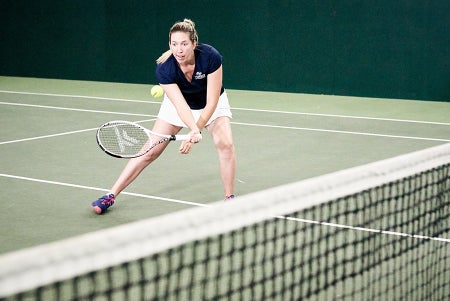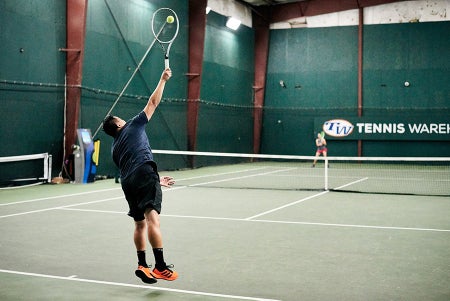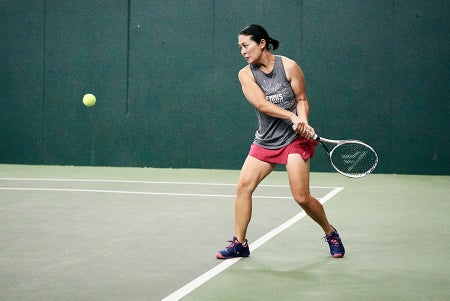Tecnifibre TFight 300 RS Racquet Review
| Overall | 83 |
|---|---|
| Groundstrokes | 84 |
| Volleys | 82 |
| Serves | 83 |
| Returns | 82 |
| Power | 82 |
| Control | 83 |
| Maneuverability | 84 |
| Stability | 80 |
| Comfort | 83 |
| Touch/Feel | 82 |
| Topspin | 84 |
| Slice | 82 |
Summary
Gone are the days of the TFight line's samurai cosmetics from a decade ago. Back then, a 300-gram version didn't even exist. Fast-forward to 2020, and Tecnifibre continues to update this control-oriented series, which now sports a clean, minimal cosmetic. The TFight 300 RS name advertises the new R-shaped beam that aims to help improve stability. If you ask our playtesters, this five-sided beam shape did its job, and they found impressive stability for a racquet weighing 11.2 ounces strung. Racquet enthusiasts' ears will also perk up when they hear that the frame is foam-injected, resulting in excellent feel. Although this TFight 300 RS focuses on control and feel, our playtesters found decent power on tap as well. Those seeking bigger plow through can look to the heavier options in the line, but players who want comfort, feel and a balance of power and control in a quick-swinging racquet should check out this TFight 300 RS.
Upsides
- Balance of power and control
- Good feel
- Easy to maneuver
Downsides
- Nothing we could agree on
Bottom Line
This TFight 300 RS provides great feel and an easy swing. There's a bit more control than power compared to most racquets in its weight class.
Ability
Intermediate to advanced
Groundstrokes - Score: 84
Sporting a new beam design, the TFight 300 RS offered our playtesters a good mix of performance features. Tiffani made some comparisons to past versions, saying, "I was getting more power than I had anticipated when I started playing with this TFight 300 RS. I've generally classified the TFight series as Tecnifibre's control line, so I was happy with the pop the stringbed was offering. This racquet felt easy to maneuver, but it still had some decent plow through and stability. I also enjoyed the racquet's feel. I remember thinking the previous XTC version felt a little too stiff for me, but I had no issues with this RS version. There was good ball pocketing, and it felt comfortable strung up with a full bed of co-poly. When I say nothing in particular stood out in terms of performance from the baseline, I don't mean it as a negative. This TFight 300 RS felt well balanced. There was a blend of power and control, and I thought spin was fine for my needs. I did prefer the tighter string pattern and heavier spec of the TFight 305 RS for slice shots, but the TFight 300 did well in that arena for a racquet with this weight and string pattern."
Brittany tapped into some unexpected power from this racquet. She described, "I have always thought of the TFight series of racquets as more control-oriented, and while I typically like their feel, I am always looking for a little more free power. I was pleasantly surprised the first time I stepped on court with the TFight 300 RS. Right away, I noticed my groundstrokes had easier power. There was a lively response off the stringbed, and the launch angle allowed me to hit deep in the court with ease. I had the ability to generate racquet head speed and flick my wrist to create some nice ball rotation."
The specs helped Mark quickly find his rhythm from the baseline. He said, "Like most players, I spend much of my time at the baseline exchanging groundstrokes, playing a ping-pong style of tennis, and Tecnifibre's new TFight 300 RS catered to hours of high-quality groundstroke exchanges. The four-point tip-light balance helped make the TFight 300 RS' substantial 320 swingweight and 11.2-ounce strung weight easier to manage. The semi-tightly spaced 16x19 pattern helped keep my backhand slice low and effective while still providing easy access to topspin. From the baseline, this was a 'point-and-shoot' racquet experience for me, and by the fifth hour of the playtest I was able to consistently hit toward the lines, keeping my opponent off balance."
This TFight 300 RS had Jason reminiscing about a popular racquet from another French company. He said, "This racquet felt maneuverable and easy to use. It was giving me Babolat Project One7 vibes — stable enough to handle most shots, yet whippy enough to generate spin easily. I loved the response and feel of the racquet as well. I would've been happy with just slightly more power, but I was pleased with the power level overall. I could still be aggressive and attack because I was able to produce plenty of spin on my shots, which helped keep the ball down in the court when I was taking full cuts at the ball."

Volleys - Score: 82
Our playtesters had few complaints when approaching the net to volley with the TFight 300 RS. Mark put the racquet's stability to the test against big hitters. He shared that experience, saying, "If the passing shot was extremely heavy (the kind Michelle typically hits), the stability of the Tecnifibre TFight 300 RS was tested a little, but in most every other instance, this frame’s weight, balance and firm layup of graphite complemented what is probably my best shot — the volley."
Brittany described this racquet's versatility. She said, "I did get to play some doubles with the TFight 300 RS, and I appreciated how quick it was through the air. I was able to hit a variety of shots, from quick reflex volleys to put-away punch volleys. I even had a couple of good half pick-up volleys, which I attribute to the excellent stability and feel. I had no complaints up at net and was very confident in the TFight 300's performance."
"I felt very comfortable using the TFight 300 RS up at net," added Jason. "With a 320 swingweight, the frame was quick to get into position on reflex volleys. I loved the feel and responsiveness of this racquet, which made it awesome on touch and drop volleys."
Like the rest of the team, Tiffani felt confident with this racquet in her hands at net. She said, "I'm not one to crash the net, but I was a fan of this TFight 300 RS on volleys. I liked how stable it felt, and I could get it into position quickly. My shots were on target, and depth came easily enough. The feel was also good, and I tried sneaking in a few touch shots here and there."

Serves - Score: 83
The even-keeled performance of the TFight 300 RS let our team hit their serves with confidence. Jason tapped into the racquet's maneuverability on this stroke. He said, "This TFight 300 RS checks just about every box for me on serve. It was easy to swing, which meant it was easy to replicate my service motion and timing, whether it was at the beginning or the end of a hitting session. The great access to spin allowed me to impart lots of rotation on both first and second serves. It's not the most powerful racquet I've hit with, but it provides more than enough pop when I need it."
With similar feedback, Tiffani added, "I had no complaints on serve. As I did from other areas of the court, I settled in pretty quickly with my service motion. The control levels let me pick my spots and hit them accurately (for me), and I could get just enough free power on my serves to be effective. For its 300-gram unstrung weight, I thought this racquet had some good plow through on serves too, so I liked hitting flat serves with it."
Brittany liked how she could mix it up when serving with the TFight 300 RS. She said, "I was actually impressed that I could crank some speedy flat first serves without too much effort. On top of that, I could rely on a couple of different serves during point play to keep my opponent guessing, including a nice slice out wide on the deuce side. I typically play with, and prefer, 100-square-inch head sizes, and I was very happy to find no adjustment period with the TFight 300's 98-square-inch head. However, I did benefit from the control, and I found I could be very precise with my serve targets. I even had the confidence to hit to a variety of targets on my second serve."
Although Mark typically prefers heavier racquets when serving, he was impressed with how this racquet deployed its weight. He explained, "On serves, racquets that weigh 300 grams generally leave me with the thought that I should be swinging a heavier racquet. That said, sometimes it feels great to be wrong, and as it turned out with the TFight 300 RS, the serve was my favorite shot. The more aerodynamic 98-square-inch head size and tip-light balance made racquet head speed easy to achieve, and its overall swingweight provided a predictable level of power on my serves."

Returns - Score: 82
The TFight 300 RS' speed through the hitting zone and its stability were highlights for our team when returning. The return of serve is one of Brittany's strengths, and she felt right at home with this racquet in her hands. She said, "While I did have success on the serve, I ultimately preferred to return with the TFight 300 RS. There was a nice balance of maneuverability and stability. I could get the racquet around my body on time, and it never felt like it was twisting in my hand. Additionally, I thought the blend of power and control was perfect for me to start the point offensively, whether I was blocking the ball back deep down the middle or going for a riskier target on a second serve."
Mark added, "My return of serve is often like a half volley, and I sort of had the same effect as I did with my volley. If the serve speed was not too excessive then the stability and plow through of the racquet were fine, but it did wobble a bit under the pressure of heavy serves."
Jason felt comfortable mixing up his returns. He explained, "Whether I was returning a big first serve or a second serve that was sitting up, I could rely on the TFight 300 RS to handle it well. It was maneuverable and stable enough to get depth on my blocked returns, and the racquet's speed and open string pattern allowed me to attack slower serves. I would've liked a bit more weight to help with both added power and stability, but that's easily done with some tungsten tape."
Returning with the TFight 300 RS came naturally to Tiffani as well. She said, "Almost right away, I felt at home with my serve returns. This racquet was pretty forgiving when I missed the sweetspot on harder first serves. It resisted twisting fairly well. I could also take a healthy swing at serves when I wanted to attack. I liked the directional control and feel, which allowed me to mix up my return tactics."
Overall - Score: 83
| Technical Specifications | ||
|---|---|---|
| Length | 27 in | 69 cm |
| Head Size | 98 sq in | 632 sq cm |
| Weight | 11.2 oz | 318 gm |
| Balance Point | 12.99 in 33 cm | 4pts Head Light |
| Construction | 23mm / 23mm / 22.5mm | |
| Composition | Dynacore HD/Graphite | |
| String Pattern | 16 Mains / 19 Crosses | |
| Babolat RDC Ratings | ||
|---|---|---|
| Score | Grade | |
| Flex Rating | 66 | Range: 0-100 |
| Swing Weight | 320 | Range: 200-400 |
| Tiffani's Scores | |||
|---|---|---|---|
| Power | 8.3 | Serves | 8.4 |
| Control | 8.4 | Groundstrokes | 8.4 |
| Maneuverability | 8.3 | Returns | 8.2 |
| Stability | 8.3 | Slice | 8.2 |
| Comfort | 8.5 | Topspin | 8.4 |
| Touch/Feel | 8.3 | Volleys | 8.3 |
| Overall | 8.4 | ||
| Brittany's Scores | |||
|---|---|---|---|
| Power | 8.6 | Serves | 8.4 |
| Control | 8.3 | Groundstrokes | 8.3 |
| Maneuverability | 8.3 | Returns | 8.5 |
| Stability | 8.2 | Slice | 8.4 |
| Comfort | 8.2 | Topspin | 8.3 |
| Touch/Feel | 8.2 | Volleys | 8.3 |
| Overall | 8.3 | ||
| Jason's Scores | |||
|---|---|---|---|
| Power | 8.2 | Serves | 8.5 |
| Control | 8.4 | Groundstrokes | 8.9 |
| Maneuverability | 8.8 | Returns | 8.9 |
| Stability | 8.3 | Slice | 8.8 |
| Comfort | 8.4 | Topspin | 9 |
| Touch/Feel | 8.6 | Volleys | 8.5 |
| Overall | 8.7 | ||
| Mark's Scores | |||
|---|---|---|---|
| Power | 7.5 | Serves | 8 |
| Control | 8 | Groundstrokes | 8 |
| Maneuverability | 8 | Returns | 7 |
| Stability | 7 | Slice | 7.5 |
| Comfort | 8 | Topspin | 8 |
| Touch/Feel | 7.5 | Volleys | 7.5 |
| Overall | 7.6 | ||
Playtester Profiles
Jason: 4.0 baseliner with a semi-western forehand and two-handed backhand. Currently using a customized Prince Twistpower X100.
Brittany: Open level player with a semi-western forehand and a two-handed backhand. She currently plays with the Yonex EZONE 100.
Tiffani: 4.0 level baseliner with a semi-western grip on the forehand and hits a two-handed backhand. Currently playing with the Prince Textreme Tour 100P (2015).
Mark: 5.0 lefty all-court player with a one-handed backhand. He currently plays with the Yonex EZONE 98+.
Likes
Tiffani - "This TFight 300 RS has good feel and stability, and a balance of control and power."
Brittany - "I like the combination of power and control, the good feel and the maneuverability."
Mark - "Relative to the prior TFight 300 XTC, the TFight 300 RS has improved stability and comfort. Another favorable trait is the TFight 300 RS' more precision-oriented and aerodynamic 98-square-inch head size, as opposed to most every other 300-gram frame being paired with a 100-square-inch hoop. Lastly, I really like the attention to detail that Tecnifibre pays to its frames, all the way down to the grommets and quality of paint."
Jason - "Great feel. Solid blend of spin, power and control."
Dislikes
Tiffani - "None really. I would say the TFight 295 RS is worth trying too; it's also impressive for its weight class."
Brittany - "There's nothing much to dislike, although nothing is a real standout feature for me. My minor dislike is that I'm not a fan of the stock grip."
Mark - "I have no specific dislikes for the TFight 300 RS , but I just prefer slightly heavier frames, like the TFight 305 RS."
Jason - "This racquet is just a tad light and could be a bit more powerful. Easy fix with tungsten tape."
Comparing the racquet to others they've tried, our testers said:
Tiffani - "For me, this TFight 300 RS has much-improved comfort and feel over the previous version. With its focus on feel and a balance of power and control, this Tecnifibre racquet had me making comparisons to the Babolat Pure Strike 16x19. For a three-pack demo, I would add in the Head Graphene 360+ Speed MP."
Brittany - "Compared to the previous XTC, I thought that the TFight 300 RS offered a little more free power with a slightly more comfortable feel. Other racquets that compare to the TFight 300 RS include the Babolat Pure Strike 16x19, Dunlop CX 200 and Head Graphene 360+ Speed MP."
Mark - "If we just compare 300-gram frames, we can include the Babolat Pure Drive, Pure Aero, Pure Strike 100, Wilson Ultra 100, Head Graphene 360+ Speed MP, Yonex EZONE and VCORE 100, Head Instinct MP and Volkl V-Cell 8. If we compare 300-gram frames that feature 98-square-inch head sizes then there are far fewer to consider. The Head Graphene 360 Radical MP, Dunlop CX 200 and Pro Kennex Ki Q+ Tour are going to be a bit closer than the others by virtue of their head size."
Jason - "From the white paint job to the playability, this TFight 300 RS reminds me of the Project One7 (Pure Strike 16x19) racquet from Babolat."